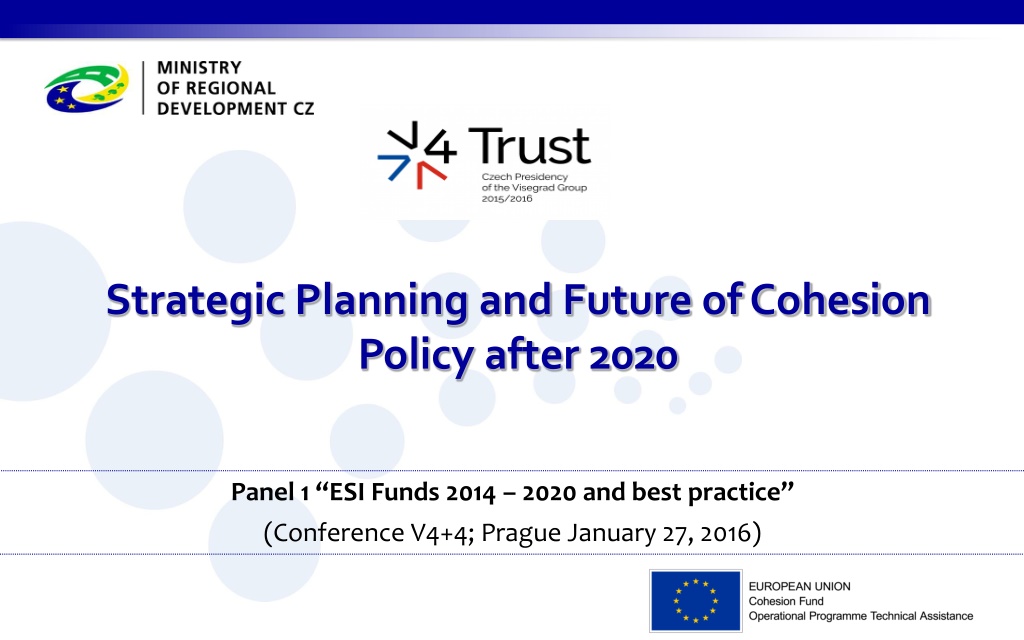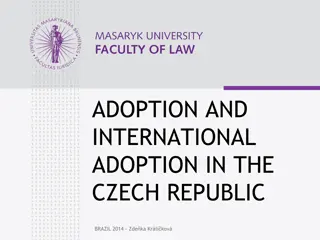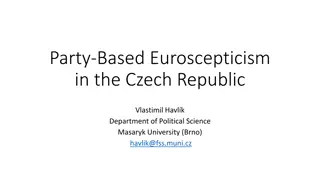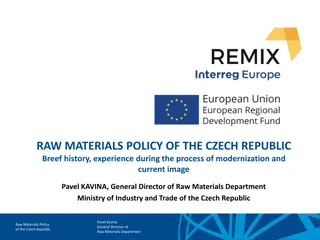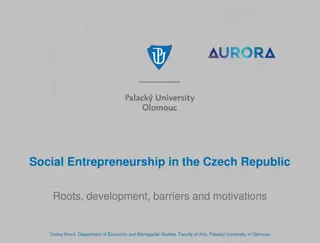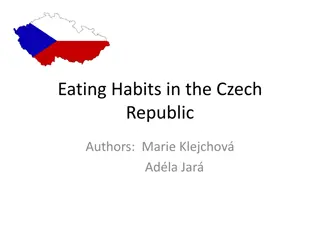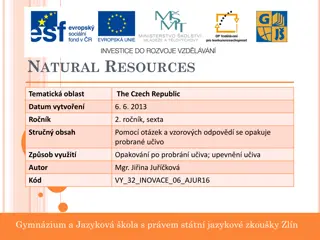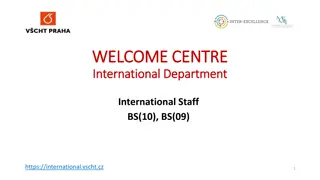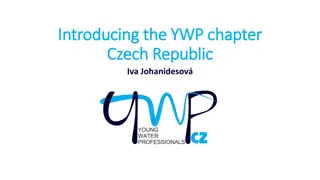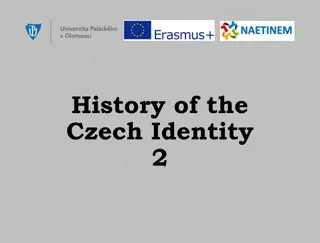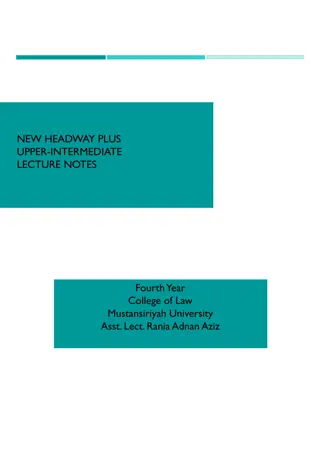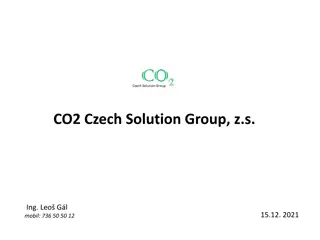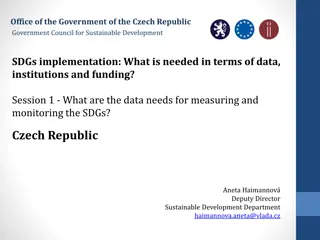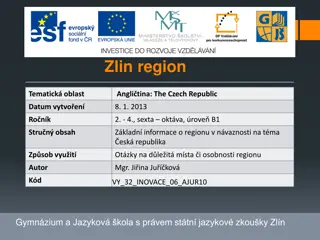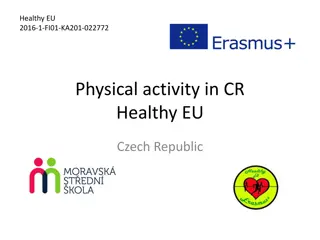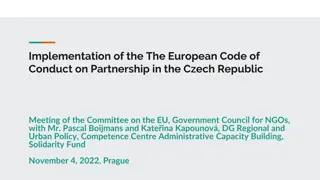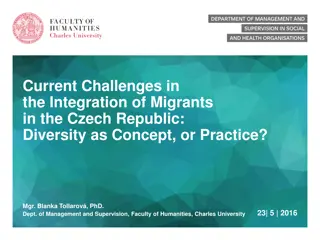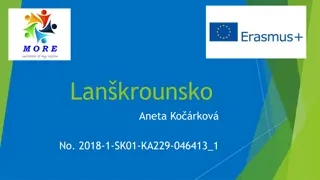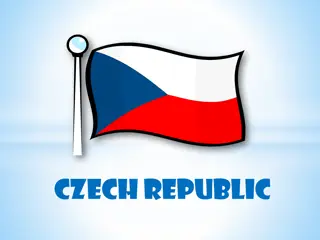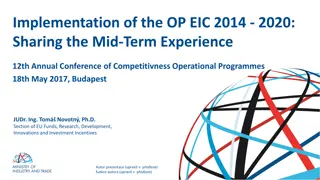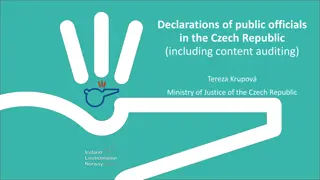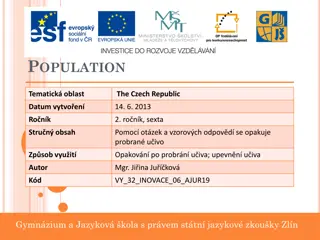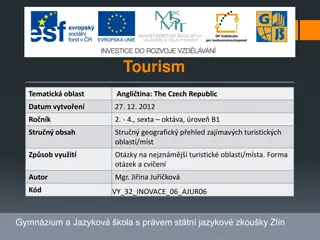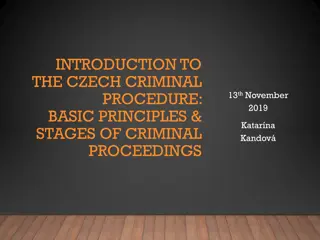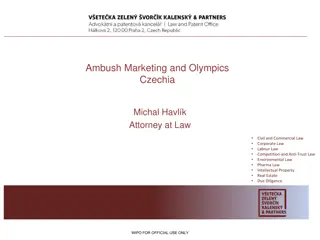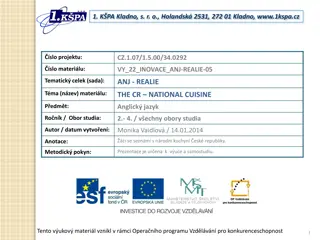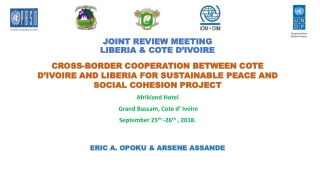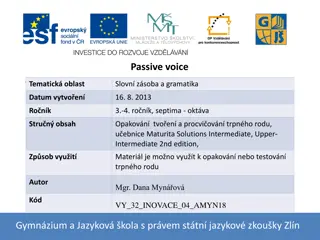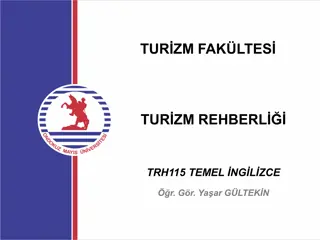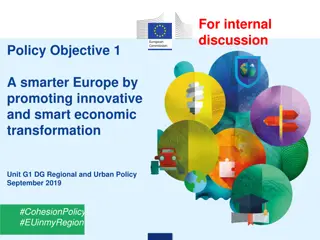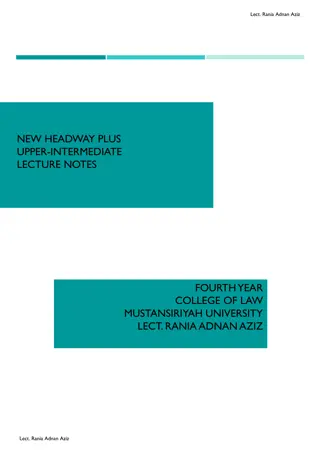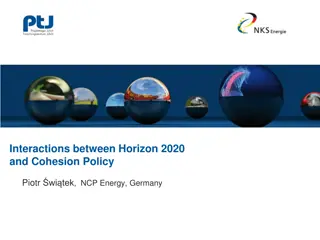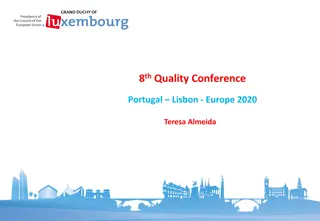Past, Present, and Future of Cohesion Policy in the Czech Republic
The impact and evolution of Cohesion Policy in the Czech Republic are highlighted through the analysis of ESI Funds, macroeconomic values, and effects on EU-15 countries. The transition from basic infrastructure investments to value-added initiatives and the role of EU funds in entrepreneurship, innovation, and energy sectors are discussed. Emphasis is placed on the direct and indirect gains from Cohesion Policy implementation, pointing to significant economic benefits and improvements in various sectors over the years.
Download Presentation

Please find below an Image/Link to download the presentation.
The content on the website is provided AS IS for your information and personal use only. It may not be sold, licensed, or shared on other websites without obtaining consent from the author. Download presentation by click this link. If you encounter any issues during the download, it is possible that the publisher has removed the file from their server.
E N D
Presentation Transcript
Strategic Planning and Future of Cohesion Policy after 2020 Panel 1 ESI Funds 2014 2020 and best practice (Conference V4+4; Prague January 27, 2016)
Last decade cohesion policy impact on the CR The CR passes already through the 3rd cohesion policy period 2004-2006, 2007-2013, 2014-2020 In the course of the period necessity to tackle the financial and economy crisis to set up the whole implementation system based on experience from the previous years Changeover from basic infrastructure investments to the value added investments
Macroeconomic value of the EU funds Entrepreneurship -improvement of the business environment, creation of new businesses and their development. Innovation -increase in the number of product innovations on the market and creation of jobs (mostly scientific), in the area of technology transfer then setting up of 8 centres of excellence and 40 regional R&D centres. One third of clustersout of the total number of clusters were supported by the EU Funds Significant improvement of transport infrastructure of regional and national importance. Energy sector -higher use of renewable sources and increase energy efficiency and reduction of consumption.
Effect of Cohesion Policy in the CZ for EU-15 countries Estimation for the whole period 2007-2013 6.5 bilEUR in total. Direct + indirect gains from the implementation of Cohesion Policy in the CZ for EU-15 countries: Direct gains emerge from companies contracts in projects co-financed from Cohesion Policy s programmes (e.g. through daughters of foreign mothers ) -France, Sweden, Germany and Austria in particular. Indirect gains emerge from spill-over effects (imported goods and services from the EU-15 countries) + in the form of consumption multiplier benefits (consequence of extra spending of the CZ consumers).
The impact of Cohesion policy in the Czech Republic Total allocation 2007-2013: 26,7 bn. EUR Economic crisis Demand reduction CNB's foreign exchange interventions
New factors the EU level Decrease in the number of Cohesion policy objectives and determining 3 region categories Thematic concentration Setting a system of ex-ante conditionalities Pressure on higher performance of the system Higher rate of application the territorial specific approach and use of integrated instruments (ITI, CLLD) Higher rate of application the financial instruments and simplified cost options E-cohesion
How to prepare the effective implementation system Experience and lessons learnt User friendly environment 3E
Lessons learnt for 2014-2020 Decrease in the number of programmes Strategic planning -determining priorities and linking programmes to CZ national development strategies Transparent processes together with the 3E principle. Rolesof institutions within the implementation chain balanced competences and responsibilities. Unifiedterminology and unified and coordinated approach to the creation of methodologies; according to the competencies of the relevant body: HR quality professionalism, responsibility, ownership. Digitalization of the administrative processes.
Partnership Agreement Problem area and development needs: Priorities of funding: Efficient and effective employment services Competitiveness of the economy (Labour market, Education, research and innovative syst m, competitive business) : High-quality education system (lifelong learning) Research and innovation system based on a high-quality research interconnected with the application sphere and targeted at marketable results Infrastructure (Transport infrastructure; ICT infrastructure; Energy infrastructure) Businesses that use R&D results, are competitive on the global market, and contribute to a low-carbon economy Public administration (Efficiency of public administration) Sustainable infrastructure facilitating economy competitiveness and adequate territorial serviceability Social inclusion, the fight against poverty and the healthcare syst m (Social inclusion; healthcare syst m) Transparent and effective public administration with low administrative and regulatory burdens and effectively responding to emergencies. Environment (Environmental Protection, Climate change) Social system encouraging the inclusion of socially excluded groups and combating poverty. Environmental and landscape protection, climate change adaptation and risk management.
Partnership Agreement - Process of preparation Preparing PA respects the principals of strategic access (application on model of the Methodology of Preparing Public Strategies). It refers to requirements of EC that requires strengthening of strategic planning process. Preparation of PA and OP is solved by strategic access incl. involvement of all injured stakeholders.
Negotiations PA and programmes Programmes Partnership agreement July 9./14.th, 2014 Approval of the programmesby the Czech government April 9th, 2014 Approval of the Partnership Agreement by the Government of the Czech Republic Until July 17th, 2014 The official submission programmesto the EC April 17th, 2014 The official submission of the Partnership Agreement to the EC September/October 2014 Receipt of official comments from the EC June 24th, 2014 Receipt of official comments from the EC July 4th, 2014 Sending the CZcomprehensive response to EC comments Formal negotiations with the EC June 2015 The Programmes were approved by the EC July 10th, 2014 Negotiations with the EC as part of a formal dialogue Negotiationsin 2014 and the first half of 2015. August 26th, 2014 The Partnership Agreement was approved by the EC
20142020 programmes Programme Allocation in billion EUR Thematic objectives Integrated Regional Operational Programme 4.63 2, 4, 5, 6, 7, 9, 10, 11 OP Transport 4.70 7 OP Environment 2.64 4, 5, 6 OP Enterprise and Innovation for Competitiveness 4.33 1, 2, 3, 4, 7 OP Employment 2.13 8, 9, 11 OP Research, development and education 2.78 1, 9, 10 OP Technical assistance 0.22 - OP Prague Growth Pole of the Czech Republic 0.20 1, 4, 8, 9, 10 2.17 1, 3, 4, 5, 6, 8, 9, 10 Rural Development Programme 0.03 3, 6 OP Fishery 23.83 TOTAL
Single methodological environment Objectives: Simplificationof the administrative process. Easier orientation of beneficiaries. Improvement of the communicationbetween beneficiaries and support providing institutions. Single and comprehensive rules at all levels. Introduction of the unified terminology (and its interpretation) across the whole implementation. Shortening of the administration period. Necessary changes in the legislative framework leading to smoother implementation.
Basic phases of simplification Submission of project application Evaluation and selection of project Implementation of the project, payments, controls Calls for proposals Unification of documentation requirements for applicants and beneficiaries; greater emphasis on management of calls for proposal, synergies and complementarities; coordination of announcements of calls for proposal; better information flows and training of potential applicants before announcement of calls for proposal. Definition of mandatory evaluation criteria; more emphasis on two- round evaluation; information for applicant about the result and the possibility of appeal; creating a joint database of evaluators, their automatic selection, evaluation and controls; set of the maximum deadlines for managing authorities for approval process. Uniform structure and content of reports on the implementation of the project; templates for use in area of public procurement; implementation of central planning, financial controls; uniform checklists; setting limits for enforcement of minor claims irregularities; harmonization of penalties for violating the rules of mandatory publicity. unified interface for applications; Connection of monitoring system MS2014 + to central public administration registers; reuse once entered informations; electronic signatures and archived electronic communications.
Territorial Dimension = Concentration and targeting of ESI funds in specific territories with specific problems to be solved but also with unique development opportunities = Two ways to implement in the Czech Rep.: Integrated tools (ITI - 7, IPTD - 6, CLLD) Projects in specific calls ( targeted calls ) - territorial, thematic or other targeting = Pressure on integrated planning and functional approach
Strengthening urban dimension in ESIF 2014- 2020 EU and national expectations Engagement of key partners from public, private and non- for-profit sector and on-going search for consensus Functional approach to urban development, incl. urban-rural links Strong coordination on the level of cities Integration of relevant topics (mobility-envi, education-labor market etc.) out-of-the-box thinking Pressure on overall quality of planning and management and project results
Launched calls for proposals Calls for proposals launched in 2015 5.0 4.5 4.0 3.5 3.0 2.5 2.0 1.5 2015 36,2 % total allocation 8,7 EURbn. 1.0 0.5 0.0 2016-2023 63,8 % total allocation 15,3EUR bn. EUR bn. OP T IROP OP EIC OP RDE OP Envi RDP OP Empl OP TP OP PGP OP F Source: MS2014+; as of January 4, 2016; EU share only; 1 EUR = 27,029 CZK Total allocation 2014-2020 Launched calls as of January 4, 2016
Launched calls for proposals Allocation (EUR million) Programme Number of calls 3,108.3 1,403.3 OP Transport 3 108,3 5 1,166.1 OP Employment 1 403,3 47 1,069.6 Integrated Regional OP 1 166,1 19 OP Enterprise and Innovation for Competitiveness 854.4 1 069,6 40 444.0 OP Environment 854,4 26 434.6 Rural Development Programme 444,0 13 226.0 OP Research Development and Education 434,6 9 41.9 OP Technical Assistance 226,0 3 9.6 OP Prague Growth Pole of the Czech Republic 41,9 10 0.0 1,000.0 2,000.0 3,000.0 4,000.0 OP Fisheries 9,6 6 EUR mil. Source: MS2014+; as of January 18, 2016; EU share only; 1 EUR = 27,029 CZK. Total 8 757,9 178
Thank you for your attention Olga Let kov , Deputy Minister (Ministry of Regional Development of the Czech Republic)
